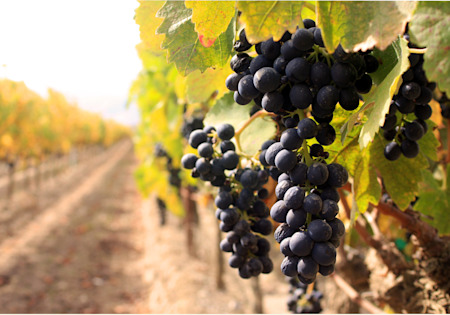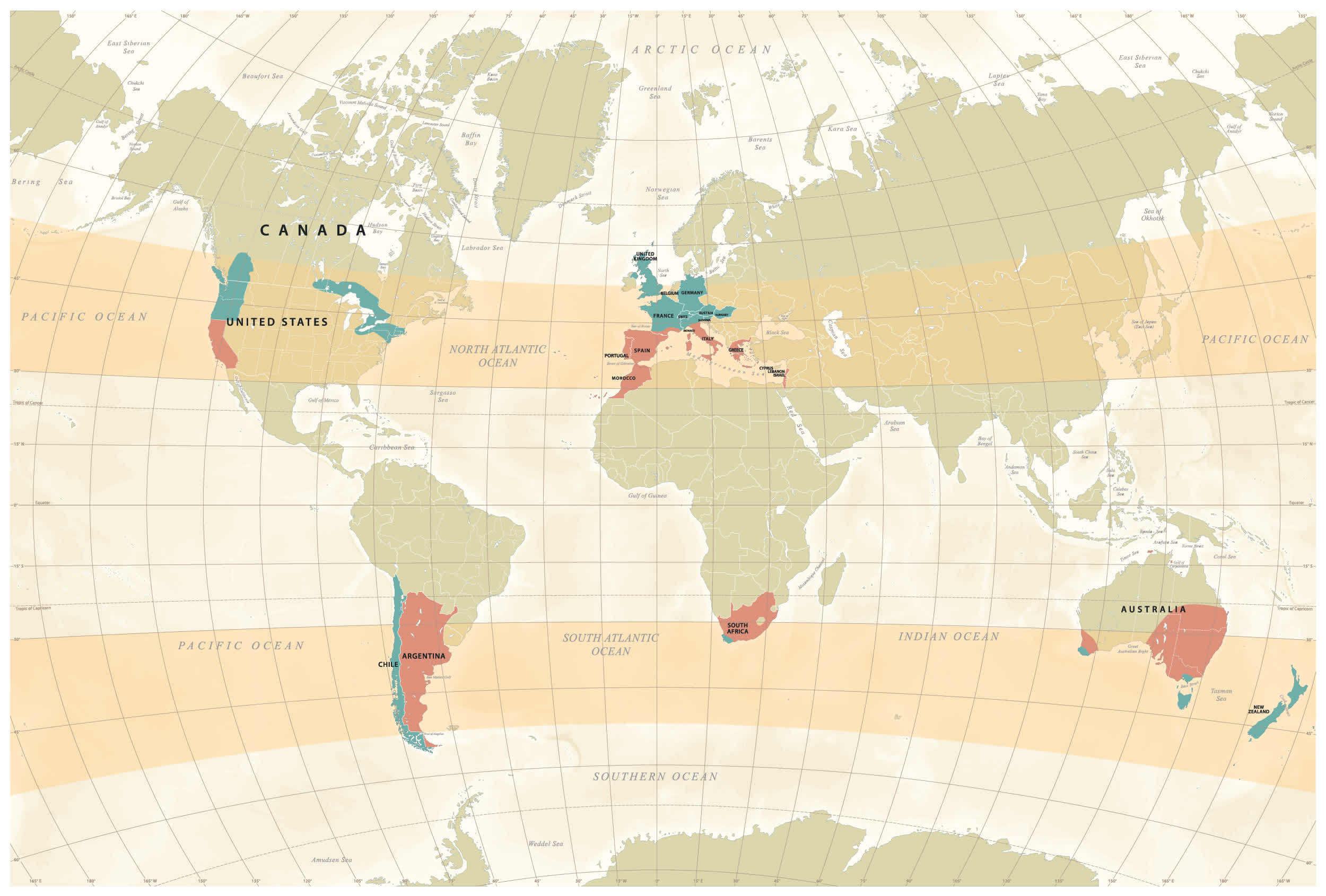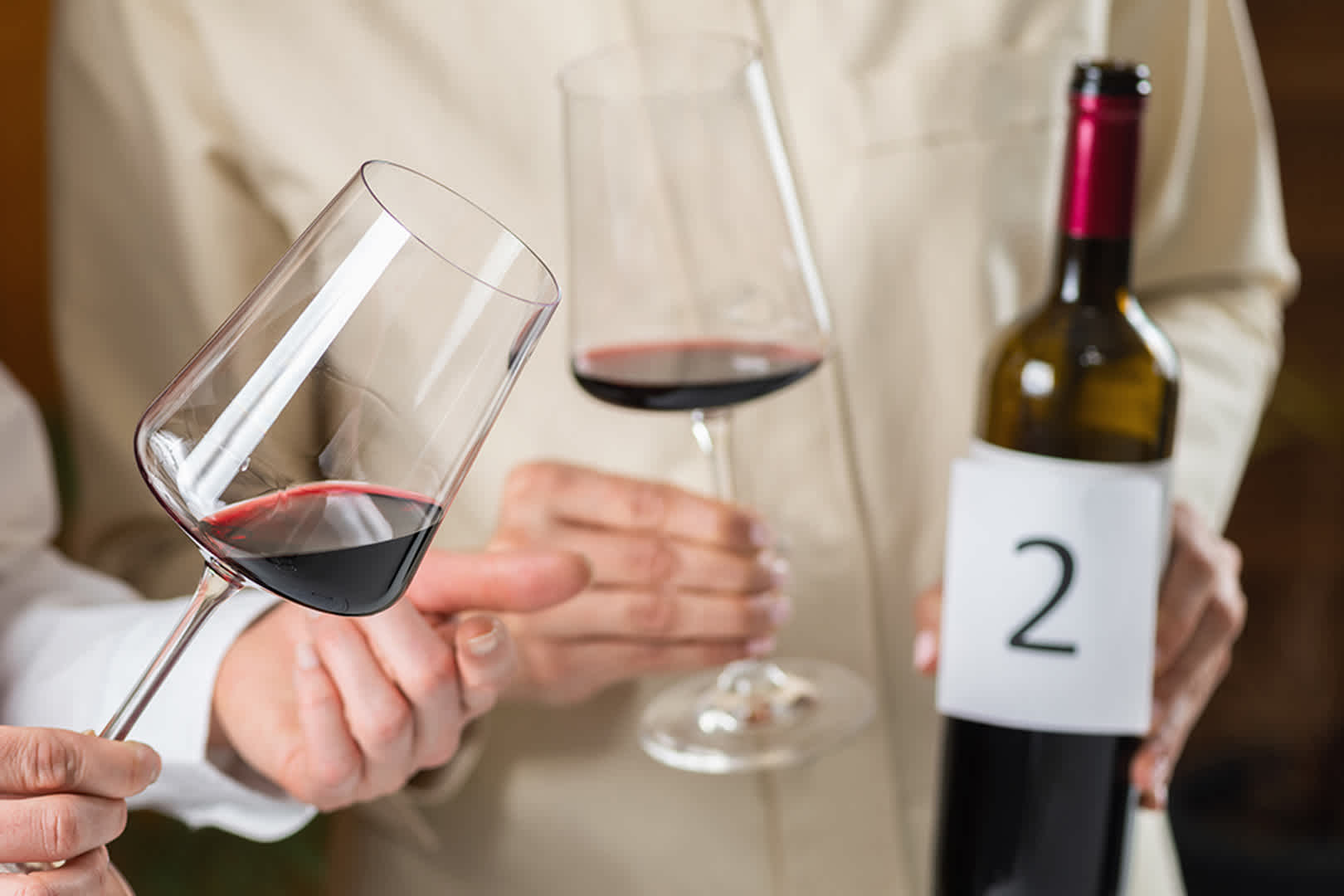Warm Climate Wines vs Cool Climate Wines
How geography affects the taste of wine
Do you find yourself consistently reaching for wines from the same region? Is there something about their taste that you can't quite pin down? Follow along as we explore key reasons why warm-climate wines and cool-climate wines taste so different. Don't worry; you won't need to revisit high school geography to keep up.
IN THIS ARTICLE:
How do grapes grow?
Growing grapes for wine, starts with the vine. Grapevines require five main things to survive; carbon dioxide, warmth, sunlight, water and soil. Since CO₂ exists in the atmosphere, it's always easy to find. However, the last four vary from region to region, shaping part of what wine connoisseurs often refer to as "terroir."
Sunlight
Like most plants, grapevines use photosynthesis to grow. Sunlight helps them produce sugars (energy) which they pump into grapes. During ripening, small, tart grapes become sweeter as sugar levels rise and natural acidity drops. These sugars are what gets converted into alcohol during winemaking.
Warmth
Generally, summer temperatures should be above 50 degrees Fahrenheit for vines to wake up from their winter nap. Consistent heat keeps vines growing and grapes ripening. If it gets too hot for too long, vines can shut down. It can be challenging for vines to survive in regions where summer temperatures regularly top 100 degrees.
Water
Hardworking vines need water to stay refreshed. It can come from rain or irrigation in regions where storms are scarce. The key is to have just enough water for a grapevine to survive. This way, it produces smaller quantities of grapes but with more flavor. Too much water and the vines will overproduce grapes, diluting the flavors.
Soil
Beyond providing somewhere to sink its roots, soil is the primary source of a vine's nutrients. These include elements like nitrogen, phosphorus, magnesium and potassium. Soil type can also affect water retention. Rocky well-draining soils are ideal in regions with lots of rainfall, while fine-grained clay soils will hang onto moisture in dry climates.
What season do grapes grow?
Grapevines follow a simple annual lifecycle where each stage is crucial for the vineyard's success.
Budbreak
Spring
Also known as budburst, this stage of the vineyard cycle signals the start of the growing season. Buds form between the leaves and shoots of a grapevine. Dormant throughout winter, these buds awaken in warm spring temperatures, bursting with fresh green growth that begins to form the vine's canopy and grapes.
Flowering and fruit set
Early summer
Small groupings of tiny white flowers form along the vine's fresh green shoots. These will eventually become grape clusters. In the early summer, each pollinated flower will drop its petals, and a tiny, green sphere will emerge. As these little grapes grow, bunches begin to take their familiar shape.
Veraison and ripening
Mid to late-summer
Mid-summer means grapes that were once hard and green are starting to swell and change color. In a process called veraison, the skins of red wine grapes turn from green to violet, while white grapes turn to gold. The berries also start to fill with natural sugars and water, acid levels drop, and flavor compounds and tannins begin to develop.
Harvest
Fall
After ripening over the long summer months, fall harvest arrives. This is the most important time of year in the wine industry. Vineyard crews have labored for months in preparation for the grand finale of picking the year's crop and handing it off to the winemaking team.
Dormancy
Winter
Once harvest is complete, it's time to rest. The leaves of the grapevines will change color and fall to the ground. Their flexible green shoots that once supported plump bunches of ripe grapes will become brown and dormant. This winter dormancy period is essential to the life cycle of the vineyard as vines enjoy some well-deserved time off. Once spring arrives, the cycle begins again!
Now that we know what a vine needs, let's look at where they grow best.
Wine grape growing zones
Most major wine regions fall between two latitude bands, 50-30°N and 30-50°S. These bands have an ideal balance of everything a vine needs. Most importantly, they have warm summers with enough sunlight to ripen grapes and cool winters for vines to rest. Generally, regions can be split into two climates; cool and warm. Cool regions tend to be farther from the equator, and warm regions are closer. Other factors can affect climate too. Some of the primary examples are:
Altitude: The higher up you go, the cooler it gets. This is why mountainous Argentina can produce cool-climate wine styles while being so close to the equator.
Oceans: Sea breezes and fog alleviate high temperatures in coastal regions like California and Chile.
Weather: Unexpected heat waves and storms can affect ripening in ways uncharacteristic of that region. This is why vintage is such a hot topic in wine.
Cool climate wines
Cool-climate wine styles will have a lighter body, lower alcohol and higher acidity. White wines often show crisp minerality, citrus, or even some herbaceous notes. Red wines will have a brightness to their character with fresh red or dark fruit notes.
Why? Less sunlight and warmth means grapes will have lower levels of their natural sugars at harvest. Less sugar means less alcohol and more acidity, which will make the body of the wine feel lighter.
Example regions: Washington, coastal California, northern France, northern Italy, South Africa, Chile
Warm climate wines
Warm-climate wine styles will have a fuller body, higher alcohol and lower acidity. White wines will often have riper stone fruit or tropical fruit notes. Reds can showcase bold dark fruit or even jammy characteristics.
Why? More sunlight and warmth means grapes will have higher levels of their natural sugars at harvest. More sugar means more alcohol and lower acidity, which makes the wine's body feel plump and full.
Example regions: Australia, Spain, southern Italy, southern France, Argentina, inland California

One grape, two ways
Fun fact! Syrah and Shiraz are actually the same grape. It's one of the only varietals that will change names depending on what style the wine is. If the label says Syrah, expect a wine with leaner textures and brighter fruit notes. If it says Shiraz, you can expect a bold and jammy wine.
Test your tastebuds
Comparing wines from different regions is a fun way to further your understanding and learn what you like. You can stay within state lines or taste across countries. Make sure you stick to the same varietal to see how it changes. We've included some examples below.
Explore a single state
Compare a Sauvignon Blanc or Chardonnay from California's chilly coastal regions to one from its warmer inland regions. Can you feel the difference in your body? Which has brighter acidity and which feels more plump? Can you taste which wine's flavors lean zestier and citrus-like and which has riper tropical or stone fruit notes?
Travel across countries
Compare a Syrah or Cabernet Sauvignon from the cool vineyards of Washington to one from sun-soaked Australia. Which version has fresher fruit characteristics, and which leans more ripe? Is one lighter on the palate while the other is bold? Most importantly, which is your favorite and why?
Try it blind
Have a friend pour your wine out of sight and present you with a glass of each. Can you tell which is which? For help, visit the Wine Tasting, Made Simple activity in our Wine School.
IN THIS ARTICLE

WinePrint™ by Firstleaf
Are you looking to learn more about your wine preferences? Check out our Wine Print for an in-depth look at your personal tasting profile. Discover your favorite wines, varietals, regions, and tasting notes and get personalized recommendations wherever you are.
Learn More


